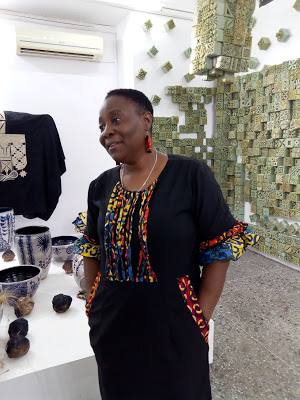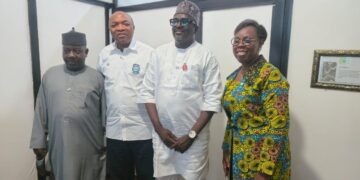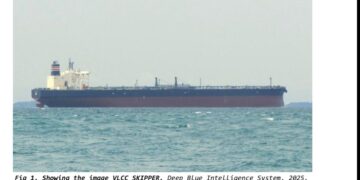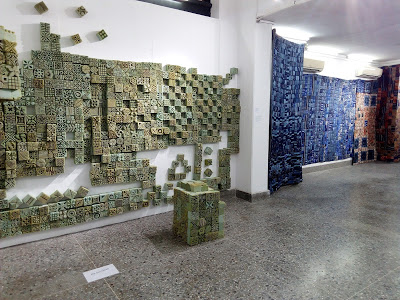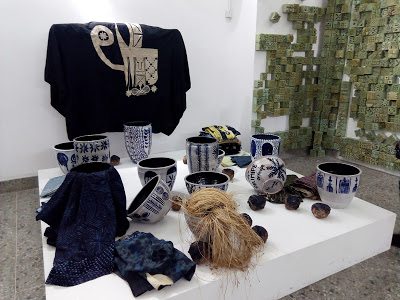The Art exhibition Indigo Reimagined put together by Peju Layiwola, an artist and Professor of Art History at the University of Lagos, is a rich history of our indigenous knowledge developed by local artists, through the art of fabric designing known as adire.
Though the collection is centred on cloth, this art historian wants her audience to understand the collection beyond the materiality of cloth. She states that “It is very important that the processes are captured, because it tells a lot about the ingenuity of the artist and the complexity of our philosophical amid scientific thoughts as a people.”
Layiwola displays technical skills in the use of other media in relating to cloth. She transfers her creative sensibilities from cloth to metal, steel, aluminum foil, ceramics and much more in tandem with local women artists whose art interconnects with other local arts and crafts.. She explains the essence of the collection as a bridge between the significance of processes and mundane tools used for designing, and the aesthetics of the finished work on cloth.
Indigo Reimagined is a solo exhibition holding at the J.F. Ade Ajayi Auditorium Gallery of the University
of Lagos, Akoka Lagos. It runs from June 13th to July 30th 2019.
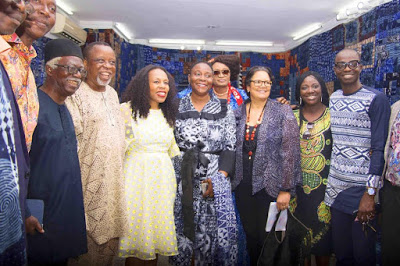 |
| The cream of Nigeria’s art society |
The underlying essence of the exhibition
It is celebrating the ingenuity of female artists who are involved in this art of painting and creating tie and dye of different methods particularly dyeing in indigo. It also recognises the ingenuity of these artists who were able to understand the alchemy of materials and the chemistry involved in extracting
blue from green leaves.
So, I am interested in the cloth, not necessarily as a form of adornment or signification, but I am also interested in the processes that are involved in the extraction of dyes as well as the patterns on tools and templates that are used for dyeing. I also argue that these patterns appear on the templates and stencils just as they appear on the cloth, yet everybody buys the cloth while the templates remain in the studios of the artists. Since the stencils, like the templates, bear the mark and designs of the artist, they can in fact, become art in themselves.
So, I have chosen to install them as art forms as a way of elevating the art beyond its usual category of a
mere craft. It therefore moves into the domain of art worthy of scholarly engagement.
The stencils actually tell us about the entry that men made into the art of fabric designing, because adire was a female preserve. It was done predominantly by women who would sit for hours
on end painting a pattern on a wrapper. In a bid to turn out more yards of dyed patterned fabrics to meet demand, men began to mass-produce using stencils and sewing machines.
|
|
|
Some of the works on display
|
What are the environmental inspirations embedded in the collection of works?
Definitely, every artist draws from the environment. Some of the things that were represented by the
artists on cloth were the flora and fauna in an environment. They also depicted historical events and places. One popular fabric is called Ibadan dun (Ibadan is sweet) usually represented by a row of columns of Mapo Hall, a colonial building used as a town hall. Another cloth with inscriptions
refers to ogun pari (war ended).
At the close of a war, the artist document this historical event as letterings on cloth. So these are things that were highlighted, and sometimes they even express their own fears and anxiety on cloth and prayers with catch phrases. Things that concern them, they also
would write their names, things that they wanted to live for. They also sought to extol their virtues like orimi pe (my head is correct). They also represented lots of animals such as tortoise, snake, lizard (alangba) etc. and represented these in their art. Object types such a combs and plants such as cassava leaves were depicted. So, the artist had an entire range of designs that they represented, and these are the things that survived till now as the classical examples of designs by the local artists.
Showcasing women’s creative strength?
Yes, it is important because sometimes women’s work are usually relegated to the background, women’s art is not given the full complement as art but defined as craft. I beg to differ from that because I know that women would do work in the context of taking care of their family and their children. One of the works in this show titled, Even Mother’s Wrapper Couldn’t Cover depicts a baby doll, showing that a child is lurking in the corner, but that does not diminish the art that they did. Women have to be extolled for the skills that they had, because they were great at multi-tasking.
One of the reasons that I did these art is to take textile from the domain of craft and to celebrate it and bring out the depth in it.
This exhibition is all about cloth, but it is not just cloth. Only one work in this exhibition is entirely made of cloth, and so, I have used other media to engage with cloth to transfer my creative sensibilities from cloth itself to other media like metal, steel, aluminum foil and other materials that would take it to the domain of scholarly discourse.
Looking at the technicality of the process in creating designs?
What we are talking about is an art and also a science. Very important, because you see the beautiful design, but you have to know how it was made. That for me is very important. For me, processes are important in this exhibition, just as the materials and the tools are important. There is a way you appreciate the art even more when you know how it was done. Likewise, the interaction between
textile and pottery also plays out here because the dyes were kept in vats, which were used as pots, and the earthenware pots which allowed in air for the growth of bacteria, which was very necessary for getting the right intensity of hue for the dye.
It is very important that the processes are captured. It tells a lot about the indigenous knowledge system and you tend to find out that sometimes it also overlaps with other art forms or craft like soap making (ose dudu). The same method of burning the ashes, the ashes that were used as lye for dissolving the dye, the same process you use to burn the ashes to make soap. So, it is very multi-layered and you can only take the layer one at a time to better appreciate things that these local craftswomen did.
Representation of the raffia strings?
The three different methods of creating designs on cloth; the first one is adire oniko, which entails tying with raffia, adire alabere – stitch and dye and Adire eleko- cassava starch painted or stenciled on cloth.
Raffia is a vegetal material, but it is no longer used as often as it should. Since the raffia is vegetal, it is not slippery to the touch like synthetic threads that we use nowadays. The raffia stays in place when tying is done. It is also very easy to loosen it up after dyeing. Sadly, we have discarded all of this organic
materials and now import synthetic materials into Nigeria, which I think is a shame.
